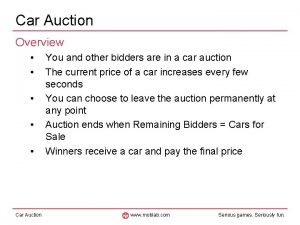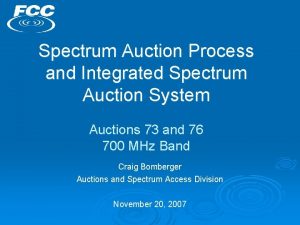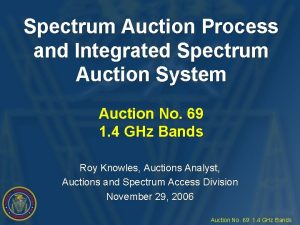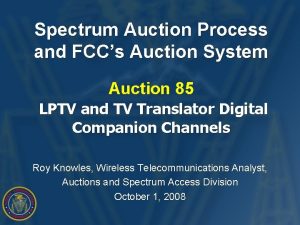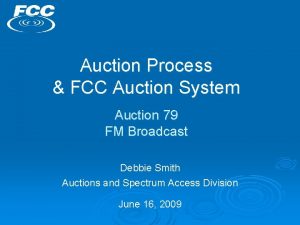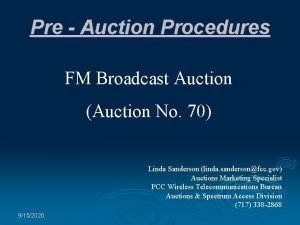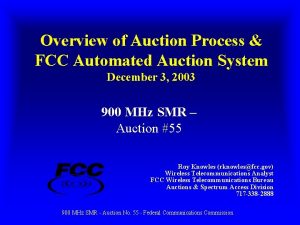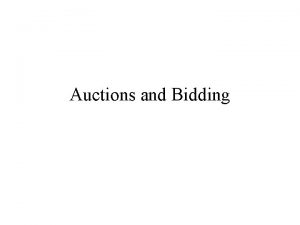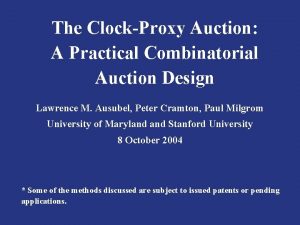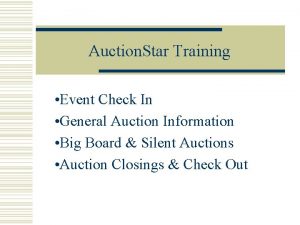Spectrum Auction Process and Integrated Spectrum Auction System



























- Slides: 27

Spectrum Auction Process and Integrated Spectrum Auction System Auction No. 62 FM Broadcast Craig Bomberger, Associate Chief Auctions and Spectrum Access Division craig. bomberger@fcc. gov July 27, 2005

Disclaimer Nothing herein is intended to supersede any provision of the Commission's rules or public notices. These slides should not be used as a substitute for a prospective applicant's review of the Commission's relevant orders, rules, and public notices. Prospective applicants must familiarize themselves thoroughly and remain current with the Commission's rules relating to the FM Broadcast service, rules relating to application and auction procedures, and the procedures, terms and conditions contained in the Auction No. 62 public notices.

Questions? If you are viewing this presentation live over the web, please feel free to e-mail your questions to… auction 62@fcc. gov

Agenda Overview of the FCC’s Simultaneous Multiple Round (SMR) Auction Design and Terminology Discuss Auction No. 62 Rules and Procedures Presentation and Hands-on Demonstration of the FCC’s Integrated Spectrum Auction System

Simultaneous Multiple Round (SMR) Auction Design • Simultaneous — All construction permits are offered at the same time. • Multiple Round — There are multiple discrete bidding rounds. − How many rounds? That’s determined by the auction. • Bidding continues until there is one round in which nothing happens. − No new bids, withdrawals, or proactive waivers.

Auction Design (continued) • Web-Based Bidding System − Option to bid via Auction Bidder Line • Click-Box Bidding − When placing a bid, a bidder selects from bid amounts in the bidding system.

Auction Design (continued) • Bidding is confidential during a round. • When a round ends, results are processed and made public. − Including provisionally winning bids (PWBs), all bids, bid withdrawals, and proactive waivers

Auction Design (continued) • Activity Requirements − Bidders must generally bid throughout the auction.

Bidding Units • A fixed number of bidding units is assigned to each construction permit in the auction. • The bidding units for each construction permit are listed in Attachment A to the procedures public notice. • Bidding units are used to measure bidders’ activity and eligibility.

Bidding Units and Eligibility — The maximum number of bidding units a bidder can bid on. • A bidder establishes its eligibility with its upfront payment. • Eligibility cannot be increased. • Eligibility is not specific to certain construction permits. A bidder may use its eligibility on any of a number of CPs it has selected on its 175 application.

Bidding Units and Activity — The sum of the bidding units for • the construction permits on which a bidder places bids in the current round, and • construction permits on which a bidder has provisionally winning bids from a previous round.

Activity Requirement • The activity requirement is the minimum number of bidding units on which a bidder must be active. It is determined by a percentage of the bidder’s current eligibility.

Activity Requirement Auction No. 62 Two Stage Auction • Stage 1: 75% activity requirement If a bidder has 10, 000 bidding units of eligibility, its activity requirement is 7, 500 bidding units. • Stage 2: 95% activity requirement If a bidder has 10, 000 bidding units of eligibility, its activity requirement is 9, 500 bidding units.

Bidding Units in Action Example: You have 20, 000 BU of eligibility and a 75% activity requirement (15, 000 BU) Description/Market Bidding Units Upfront Payment FM 372 Burlington 20, 000 $20, 000 FM 365 Coalinga 15, 000 $15, 000 FM 375 Silverton 5, 000 $5, 000 Area What can you bid on? • Burlington or Coalinga and Silverton • Not Silverton by itself (doesn’t meet activity requirement) • Not Burlington and Coalinga; not Burlington and Silverton (exceeds eligibility)

Activity Requirement What if you do not meet the activity requirement? One of two things will happen: • You will use an activity rule waiver. or • Your eligibility will be reduced.

Activity Rule Waivers • Use of an activity rule waiver preserves a bidder’s current eligibility despite the bidder’s activity in the current round being below the required level. • When a bidder uses an activity rule waiver, the waiver applies to that round of bidding, not to a particular construction permit.

Activity Rule Waivers • Bidders are provided with a limited number of activity rule waivers. • In Auction No. 62, each bidder is provided three activity rule waivers.

Automatic Waivers The system will automatically apply a waiver for a bidder at the end of any round in which the bidder’s activity is below the required level unless: • The bidder has no more activity rule waivers. or • The bidder reduces eligibility.

Proactive Waivers • Bidders can apply activity rule waivers proactively. • The important difference between an automatic waiver and a proactive waiver is that a proactive waiver keeps the auction open. • Bidding continues until there is one round in which nothing happens. −No new bids, withdrawals, or proactive waivers.

Eligibility Reduction What if a bidder does not meet the activity requirement and does not have any waivers left? The bidder’s current eligibility will be permanently reduced, possibly eliminating the bidder from further bidding in the auction.

Eligibility Reduction Bidders may use the reduce eligibility function of the auction system. − Reducing eligibility will bring a bidder into compliance with the activity rule. − Useful when a bidder is not meeting the activity requirement, does not want to bid on additional construction permits, and does not want to use an activity rule waiver.

What if you change your mind? • You can remove a bid you placed during the current round. If you place a bid during a round and then remove that bid before the end of the round, it’s as if it never happened. • You can withdraw PWBs from prior rounds. Bid withdrawals have limits and consequences: − Each bidder is limited to withdrawals in no more than one round in Auction No. 62. − Withdrawals are subject to the bid withdrawal payments specified in 47 C. F. R. § 1. 2104(g).

Bid Amounts • Minimum opening bids are established prior to the auction. • Minimum acceptable bid percentage and bid increment percentage are set at 10% (subject to change). − Minimum acceptable bids will be approximately 10 percent greater than the provisionally winning bids. The auction system allows for a total of nine bid amounts for each construction permit.

Bid Amounts • For activity and eligibility, the dollar amount of a bid does not matter. • How much can you bid? Any one of nine pre-defined dollar amounts. • The upfront payment does not constrain how much you may bid for a construction permit.

The Secur. ID Card Multiple cards sent to all bidders Random number refreshes every 60 seconds Countdown indicator Please return to the FCC for recycling

To Ensure a Positive Auction Experience Do your homework. − Read all public notices related to this auction. Participate in the mock auction. − Test backup strategies and activate all Secur. ID cards. − Use Auction Bidder Line to ask “what if” questions. Check for and read all announcements to stay informed. − Bidding schedule − Auction parameter changes Bid Early! − Print round summaries.

Auction Conceptual Design
 Chromium orbital configuration
Chromium orbital configuration Reverse auction process flow
Reverse auction process flow Absortpion
Absortpion What is shill bidding
What is shill bidding North east and north cumbria integrated care system
North east and north cumbria integrated care system Integrated payroll and personnel information system
Integrated payroll and personnel information system Disadvantages of integrated delivery system
Disadvantages of integrated delivery system Vertical integration
Vertical integration Integrated public alert and warning system
Integrated public alert and warning system Integrated commissioning and progress system
Integrated commissioning and progress system Integrated product teams
Integrated product teams Integrated business processes with erp systems
Integrated business processes with erp systems Control process example
Control process example Designing and managing integrated marketing communications
Designing and managing integrated marketing communications Product process spectrum
Product process spectrum Coin operated amusement machine provider in georgia
Coin operated amusement machine provider in georgia Ez auction
Ez auction Metaljunction auction login
Metaljunction auction login Reverse image
Reverse image Descending clock auction
Descending clock auction Auction in monopoly
Auction in monopoly Zango auction results
Zango auction results Penny auction statistics
Penny auction statistics![Ice] inkan auction Ice] inkan auction](data:image/svg+xml,%3Csvg%20xmlns=%22http://www.w3.org/2000/svg%22%20viewBox=%220%200%20200%20200%22%3E%3C/svg%3E) Ice] inkan auction
Ice] inkan auction Car auction game
Car auction game Bgs auction
Bgs auction Nj bgs auction
Nj bgs auction Values auction exercise
Values auction exercise







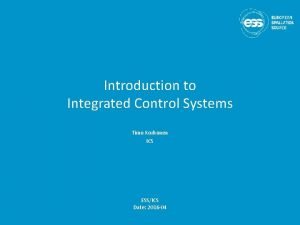
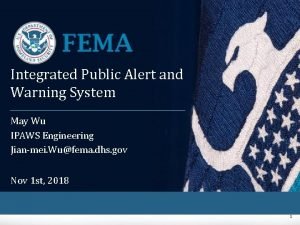


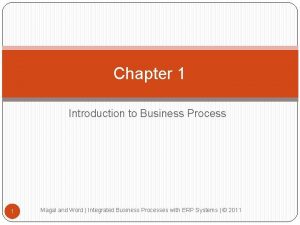
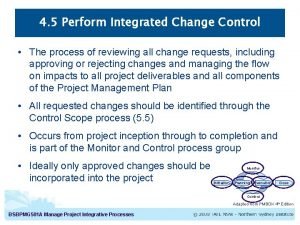

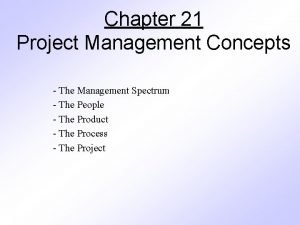

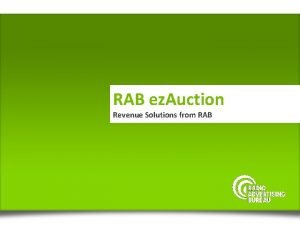
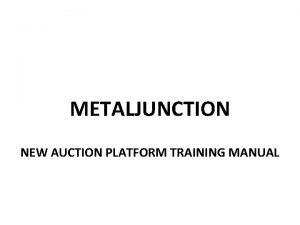
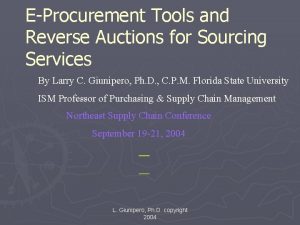




![Ice] inkan auction Ice] inkan auction](https://slidetodoc.com/wp-content/uploads/2021/03/4265618_1c2d54474a1aa46eca42079887e1f0d3-300x225.jpg)
